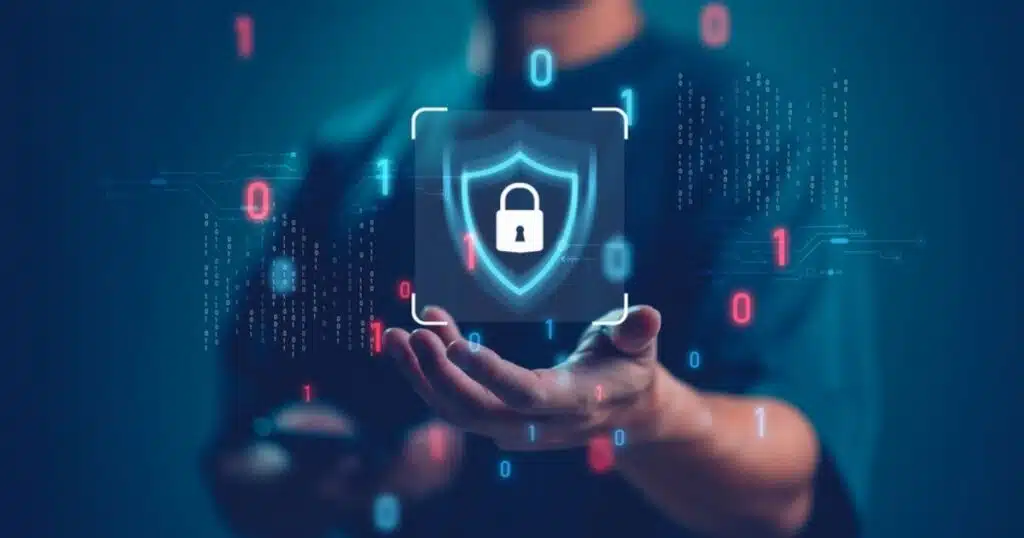In the fast-paced digital era, small businesses face increasing threats that can compromise their operations, customer trust, and even their existence.
Cybersecurity isn’t just a concern for large corporations; it’s equally crucial for small businesses.
These enterprises often hold sensitive data but lack the robust security measures of larger firms, making them attractive targets for cybercriminals.
The Growing Threat Landscape
The digital landscape is rife with hazards such as cyber attacks and data breaches, which have escalated in both frequency and sophistication.
For small businesses, the repercussions of these threats are severe, as they can disrupt business operations and lead to significant financial losses.
With limited resources to recover, small businesses must prioritize cybersecurity to protect their assets and maintain customer trust.
| Threat Type | Description | Potential Impact |
| Phishing Attacks | Fraudulent attempts to obtain sensitive information. | Unauthorized access to business and customer data. |
| Ransomware | Malicious software that locks access to user data. | Financial losses and operational disruption. |
| Data Breaches | Unauthorized access to sensitive data. | Financial loss, reputational damage, legal penalties. |
The Cost Of A Cyber Attack
The impact of a cyber attack extends beyond immediate financial losses.
The reputational damage from a data breach can deter customers, potentially crippling future revenue.
According to a report by Verizon, 43% of cyber attacks target small businesses, and the average cost of a data breach for small to medium-sized businesses can exceed $2.5 million.
This makes it imperative for small businesses to fortify their defenses against these digital threats.
Understanding Your Risks
Conducting A Security Risk Assessment
A fundamental step in fortifying your business against cyber threats is conducting a security risk assessment.
This process helps you identify critical data that could be targeted by cybercriminals and assess the relative risk to your operations.
Understanding what specific data needs protection allows you to tailor your cybersecurity plan effectively.
Common Threats To Small Businesses
Small businesses often face phishing attacks and malware, which are among the most prevalent threats.
These attacks can lead to compromised systems and unauthorized access to sensitive data.
Training employees to recognize and report phishing attempts is a critical step in mitigating this risk.
Mobile Devices: A Growing Security Concern
The use of mobile devices in business operations has introduced new security challenges.
These devices can be a source of data loss if not adequately secured.
Unauthorized access via lost or stolen mobile devices can expose business data and sensitive customer information to cybercriminals.
Implementing security measures like strong passwords, encryption, and remote wipe capabilities is essential to safeguard mobile devices used in business operations.
Building Your Cybersecurity Strategy
As a seasoned digital transformation specialist, I have seen first-hand the devastating impact a lack of cybersecurity can have on small businesses.
From data breaches that expose customer information to cyber attacks that cripple daily operations, the risks are real and can be catastrophic.
That’s why it’s critical for every small business to develop a robust cybersecurity strategy.
Here, I’ll guide you through setting up fundamental security practices, securing your network, and protecting your most valuable assets.
Implementing Basic Security Practices
The foundation of any cybersecurity plan involves basic security practices that are easy to implement but significantly enhance your security posture.
- Strong Passwords: One of the simplest yet most effective ways to protect your accounts. Ensure all business devices and accounts use strong passwords. A strong password includes a mix of letters, numbers, and symbols and is unique to each account.
- Antivirus Software: Installing reliable antivirus software on all systems helps detect and eliminate malicious software before it can do harm. Make sure your antivirus is always up to date to fend off the latest threats.
Implementing these practices doesn’t just safeguard your business; it also sets a standard for your team, emphasizing the importance of cybersecurity in daily operations.
Network Security: Securing Your Digital Perimeter
Network security is crucial as it protects the usability and integrity of your network and data.
It includes both hardware and software technologies.
- Firewalls: A robust firewall acts as a barrier between your internal network and incoming traffic from external sources (internet) that might carry cyber threats. Configure your firewall to block access to known malicious IPs and monitor outgoing traffic to prevent data leaks.
- Wi-Fi Encryption: Secure your Wi-Fi networks with strong encryption protocols like WPA3. Change the service set identifier (SSID) to something that does not give away your business identity and disable broadcasting to make your network less visible.
These measures help create a secure boundary around your digital assets, protecting them from unauthorized access and threats.
Data Security: Protecting Your Most Valuable Assets
Data security focuses on protecting your business’s critical data from unauthorized access, corruption, or theft throughout its lifecycle.
- Data Encryption: Encrypt sensitive data both in transit and at rest. Encryption makes your data unreadable to unauthorized users, providing a strong layer of security even if data is intercepted.
- Access Control: Implement strict access control measures. Ensure that only employees who need access to sensitive data to perform their job duties can access it. Use role-based access controls to minimize the risk of internal threats and accidental breaches.
By protecting your data, you ensure the privacy and security of your customer information and business intellectual property, which are often the targets of cyber attacks.
Essential Security Measures
While establishing basic practices and securing both network and data are foundational, enhancing your security with additional measures can further reduce the risk of cyber incidents.

These next steps are vital for reinforcing your cybersecurity framework.
Multi-Factor Authentication: Adding An Extra Layer Of Protection
Multi-factor authentication (MFA) is a security system that requires more than one method of authentication from independent categories of credentials to verify the user’s identity for a login or other transaction.
MFA combines two or more independent credentials: what the user knows (password), what the user has (security token), and what the user is (biometric verification).
- Implementing MFA: Enforce MFA on all systems, especially those accessing sensitive data. This practice drastically reduces the risk of unauthorized access due to compromised passwords.
Using MFA can be one of the most effective defenses against cyber attacks, particularly phishing scams and identity theft.
Data Loss Prevention Strategies
In any cybersecurity plan, preventing data loss is crucial.
This involves strategies to protect data from being lost, stolen, or accidentally deleted.
- Implementing Removable Media Restrictions: Restrict the use of removable media such as USB drives, which are a common source of data leakage and malware infections. Implement policies that control the use of these devices and include scanning them for malware before any data transfer.
- Data Backup: Regularly back up data and ensure that backups are stored securely, preferably off-site. This protects your business from data loss due to cyber attacks, natural disasters, or hardware failures.
These strategies help safeguard your data by controlling how it is accessed and transferred while preparing your business for recovery should data loss occur.
Continuous Vulnerability Management
Regularly assessing and addressing vulnerabilities in your cybersecurity is essential for maintaining the security integrity of your systems.
- Regular Security Checks: Conduct regular security audits and assessments to identify and address vulnerabilities in your systems. This includes evaluating both hardware and software components.
- Patch Updates: Stay on top of security patches and updates for your operating systems, applications, and network hardware. Manufacturers often release these patches to fix security vulnerabilities that have been discovered.
A continuous vulnerability management strategy ensures that potential security weaknesses are addressed promptly, reducing the window of opportunity for cybercriminals to exploit these vulnerabilities.
Empowering Your Employees
In my role as a Digital Transformation Specialist, I’ve witnessed firsthand how crucial it is to empower employees with the right knowledge and tools to protect against cyber threats.
Here’s how you can create a secure environment through informed and vigilant teams.
Creating Security Policies: What Employees Need To Know
Developing clear and effective security policies is the cornerstone of a small business’s cybersecurity plan.
- Acceptable Use Policy: Clearly define what constitutes acceptable use of company devices and internet. This includes guidelines on downloading software, accessing websites, and handling sensitive data.
- Password Hygiene: Implement policies that enforce strong passwords and regular updates. Employees should understand the importance of using complex passwords and avoiding the reuse of passwords across multiple sites.
These policies not only set expectations but also provide a baseline for security practices within your company.
Security Awareness Training: Educating Employees On Cyber Threats
Continuous education on cyber threats is vital. Regular training sessions can help employees stay updated on the latest cyber threats and learn how to handle them.
- Include modules on identifying phishing emails, the importance of maintaining software updates, and the consequences of data breaches.
- Use real-world examples to illustrate potential security threats and effective responses.
Phishing Simulations: Testing Employee Preparedness
Simulated phishing attacks are practical exercises to test and reinforce employees’ readiness against cyber attacks.
- Conduct regular simulations to gauge employee awareness and preparedness.
- Review the results to identify weaknesses and provide targeted training to areas where employees show vulnerabilities.
Incident Response And Recovery
Having a proactive incident response and recovery plan is crucial to minimize the impact of a cyber attack or data breach.
Developing A Data Breach Response Plan
A well-defined data breach response plan is essential to quickly and effectively handle security incidents, minimizing damage and restoring operations.
- Identifying Procedures: Outline clear steps to be taken in the event of a data breach, including containment strategies and assessment processes.
- Reporting to Authorities: Understand legal requirements and have contact information ready for reporting breaches to relevant government agencies. This not only complies with regulations but can also provide access to additional resources and support.
| Step | Action Item | Responsible Person/Department |
| Detection | Identify and confirm the breach occurrence. | IT Department |
| Containment | Isolate affected systems to prevent further damage. | IT Security Team |
| Assessment | Assess the scope and impact of the breach. | Security Analyst |
| Notification | Notify all impacted parties and authorities as required. | Compliance Officer |
| Recovery | Restore and secure systems to resume normal operations. | IT Department |
| Post-Incident Analysis | Review the incident and update security measures. | Management Team |
Setting Up Reporting Procedures
Encourage a culture where employees feel responsible for the cybersecurity health of the business.
- Implement clear procedures for employees to report any suspicious activity or potential breaches.
- Make sure these procedures are straightforward and accessible to ensure that employees do not hesitate to report incidents.
Regularly Backing Up Your Data
Regular backups are a critical safety net in maintaining the integrity of your data.
- Secure Data Storage: Store backups in secure locations, ideally both on-site and off-site. Use encryption to protect backup data.
- Remote Backup Solutions: Consider cloud-based backup solutions that offer automated, encrypted backups and remote access to data, which can be crucial during a disaster recovery scenario.
Maintaining Your Cybersecurity Posture
In the fast-paced world of cyber security, staying informed and agile is crucial.

Here are key strategies to ensure your cybersecurity measures remain effective:
Staying Up-To-Date With The Latest Threats
The cyber threat landscape is constantly changing, with new vulnerabilities and attack methods emerging regularly.
- Cybersecurity News: Subscribe to trusted cybersecurity news sources to stay informed about the latest threats and protective measures.
- Industry Best Practices: Join industry forums and attend relevant webinars and conferences to learn about the latest in cybersecurity from experts.
This ongoing education helps you anticipate and mitigate potential security challenges before they can impact your business.
Regularly Reviewing And Updating Your Cybersecurity Plan
A static cybersecurity plan quickly becomes obsolete.
To protect your business and sensitive data effectively, you must regularly review and update your security measures.
- Adapt to Changing Threats: Schedule bi-annual reviews of your cybersecurity plan to assess its effectiveness and make necessary adjustments.
- Security Assessments: Conduct regular security risk assessments to identify new vulnerabilities within your network and systems.
These reviews ensure that your cybersecurity measures evolve in tandem with new threats and technological advancements.
Considering Professional Guidance
Sometimes, the best way to ensure your cybersecurity measures are comprehensive is to seek professional guidance.
- Consulting Cybersecurity Experts: Engage with cybersecurity consultants who can offer personalized advice and strategies tailored to your business’s specific needs.
- Continuous Professional Support: Consider ongoing support from cybersecurity firms to help manage and update your security measures regularly.
Professional insights can provide peace of mind and significantly enhance your company’s security posture.
Conclusion
Cybersecurity: An Ongoing Process, Not A One-Time Event
My experience at SteveOnDigital underscores that effective cybersecurity is not a one-off task but an ongoing process that requires continuous attention and adaptation.
Small businesses must be proactive, not reactive, in their approach to cybersecurity.
The Importance Of Building A Culture Of Security
Cultivating a culture of security within your organization is critical.
It’s about making cybersecurity a core part of your business operations and instilling good security practices in every team member, from top management down to temporary staff.
Resources For Small Businesses
Several resources are available to help small businesses enhance their cybersecurity measures:
- Government Agencies: Entities like the U.S. Small Business Administration (SBA) offer tools and guides to help small businesses understand and implement strong cybersecurity practices.
- Cybersecurity Frameworks: Frameworks such as the National Institute of Standards and Technology (NIST) Cybersecurity Framework provide structured models for managing cybersecurity risks effectively.
Utilizing these resources can help small businesses develop a robust cybersecurity plan that guards against both current and emerging threats.
By embracing a continuous and proactive approach to cybersecurity, small businesses like ours can significantly enhance their resilience against cyber threats.
The journey towards a secure business environment is ongoing, requiring vigilance, education, and adaptability.
Creating a culture of security is about more than just implementing technical measures.
It involves educating every team member about the importance of cybersecurity and empowering them to take part in safeguarding the business.
Regular training, updates, and a clear communication channel for discussing cybersecurity issues are essential for fostering this culture.
In conclusion, as we’ve explored throughout this blog post, establishing a cybersecurity plan for your small business is not just a necessity but a foundation for sustainable business growth and trust.
Cybersecurity is dynamic, so your approach should adapt as new threats and technologies evolve. Remember, a secure business not only protects itself from cyber threats but also builds trust with its customers, enhancing its reputation and competitive edge.
For additional resources and guidance, small businesses should leverage offerings from government agencies and adopt industry-standard cybersecurity frameworks to ensure comprehensive coverage of their cybersecurity needs.
By doing so, businesses like ours can not only protect themselves against immediate threats but also prepare for future challenges, ensuring that cybersecurity remains an integral part of our operational strategy.
Thank you for following along with this guide on creating a small business cybersecurity plan.
At SteveOnDigital, we are committed to helping you navigate the complex world of digital security with practical, easy-to-implement solutions.
Remember, in the digital age, being proactive about cybersecurity is not just good practice—it’s essential to your business’s longevity and success.




